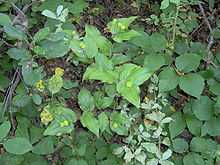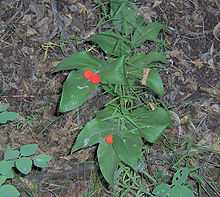Prosartes trachycarpa
| Prosartes trachycarpa | |
|---|---|
 | |
| Scientific classification | |
| Kingdom: | Plantae |
| (unranked): | Angiosperms |
| (unranked): | Monocots |
| Order: | Liliales |
| Family: | Liliaceae |
| Genus: | Prosartes |
| Species: | P. trachycarpa |
| Binomial name | |
| Prosartes trachycarpa S. Watson | |
Prosartes trachycarpa, or Rough-Fruited Fairybells or Rough-Fruited Mandarin, is a member of the genus Prosartes of perennial flowering plants in the family Liliaceae. This species was previously placed in the genus Disporum.[1] The flowers are delicate and hang down. The berry is larger than a Saskatoon, pincherry or chokecherry, about the size of a grocery store cherry or small grape. The rough-fruited fairybell can be found in the same locale as other native fruits such as Saskatoons, and Chokecherries.[2][3][4] This perennial is 30 centimeters (12 in) to 60 centimeters (24 in) in height. The leaves alternate and are about 3 centimeters (1.2 in) to 8 centimeters (3.1 in) Berries begin yellow, then orange and when fully ripe are red. The surface of the fruit feels fuzzy and velvety. The images of the rough-fruited fairy bell here were photographed as one was climbing up the riverbank of the South Saskatchewan River south of Saskatoon. The first nations ate fairybells, and a previous name was dog feet.[5]
The species shown, Prosartes trachycarpa (rough-fruited fairybell) is found in western Canada. They are listed amongst plants found in the Prince Albert National Park and Riding Mountain National Park and are considered a common range plant of northern Saskatchewan.[6][7]


External links
References
- ↑ Flora of North America on-line
- ↑ Vance, F.R.; Jowsey, J.R.; McLean, J.S. (1977), Wildflowers Across the Prairies, Saskatoon, SK: Western Producer Books, p. 141, ISBN 0-919306-74-8
- ↑ Vance, F R; J.R. Rowsey, J.S Maclean and F.A. Switzer (1999), Wildflowers across the prairies With a new section on Grasses, sedges and rushes, Vancouver, British Columbia: Western Producer Prairie Books, p. 25, ISBN 1-55054-703-8
- ↑ Wilkinson, Kathleen (1999), Wildflowers of Alberta A Guide to Common Wildflowers and Other Herbaceous Plants, Edmonton Alberta: Lone Pine Publishing and University of Alberta, p. 19, ISBN 0-88864-298-9
- ↑ Johnson Kershaw, MacKinnon Pojar (1995), Plants of the Western Boreal Forest and Aspen Parkland, Edmonton Alberta: Lone Pine Publishing and the Canadian Forest Service., p. 83, ISBN 1-55105-058-7
- ↑ Innvista, Prince Albert National Park, retrieved 2008-08-03
- ↑ common range plants of northern Saskatchewan, retrieved 2008-08-03
| Wikimedia Commons has media related to Disporum trachycarpum. |